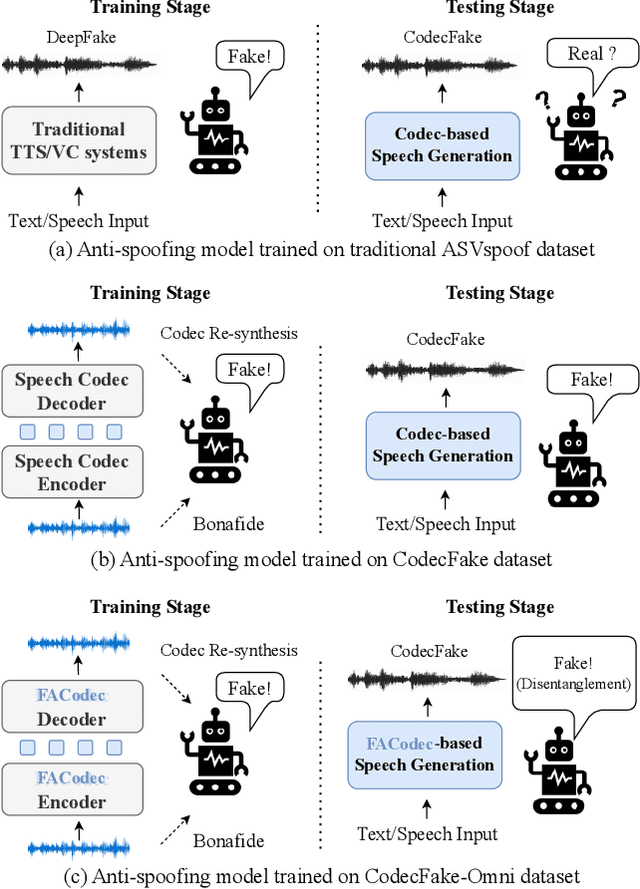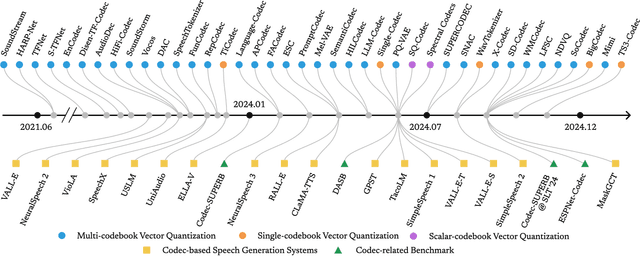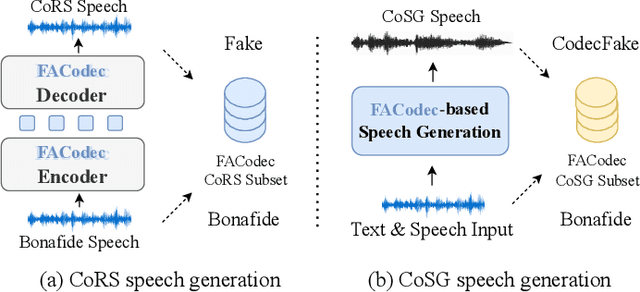Jiawei Du
Rethinking Agent Design: From Top-Down Workflows to Bottom-Up Skill Evolution
May 23, 2025Abstract:Most LLM-based agent frameworks adopt a top-down philosophy: humans decompose tasks, define workflows, and assign agents to execute each step. While effective on benchmark-style tasks, such systems rely on designer updates and overlook agents' potential to learn from experience. Recently, Silver and Sutton(2025) envision a shift into a new era, where agents could progress from a stream of experiences. In this paper, we instantiate this vision of experience-driven learning by introducing a bottom-up agent paradigm that mirrors the human learning process. Agents acquire competence through a trial-and-reasoning mechanism-exploring, reflecting on outcomes, and abstracting skills over time. Once acquired, skills can be rapidly shared and extended, enabling continual evolution rather than static replication. As more agents are deployed, their diverse experiences accelerate this collective process, making bottom-up design especially suited for open-ended environments. We evaluate this paradigm in Slay the Spire and Civilization V, where agents perceive through raw visual inputs and act via mouse outputs, the same as human players. Using a unified, game-agnostic codebase without any game-specific prompts or privileged APIs, our bottom-up agents acquire skills entirely through autonomous interaction, demonstrating the potential of the bottom-up paradigm in complex, real-world environments. Our code is available at https://github.com/AngusDujw/Bottom-Up-Agent.
Codec-Based Deepfake Source Tracing via Neural Audio Codec Taxonomy
May 19, 2025Abstract:Recent advances in neural audio codec-based speech generation (CoSG) models have produced remarkably realistic audio deepfakes. We refer to deepfake speech generated by CoSG systems as codec-based deepfake, or CodecFake. Although existing anti-spoofing research on CodecFake predominantly focuses on verifying the authenticity of audio samples, almost no attention was given to tracing the CoSG used in generating these deepfakes. In CodecFake generation, processes such as speech-to-unit encoding, discrete unit modeling, and unit-to-speech decoding are fundamentally based on neural audio codecs. Motivated by this, we introduce source tracing for CodecFake via neural audio codec taxonomy, which dissects neural audio codecs to trace CoSG. Our experimental results on the CodecFake+ dataset provide promising initial evidence for the feasibility of CodecFake source tracing while also highlighting several challenges that warrant further investigation.
DPGP: A Hybrid 2D-3D Dual Path Potential Ghost Probe Zone Prediction Framework for Safe Autonomous Driving
Apr 23, 2025Abstract:Modern robots must coexist with humans in dense urban environments. A key challenge is the ghost probe problem, where pedestrians or objects unexpectedly rush into traffic paths. This issue affects both autonomous vehicles and human drivers. Existing works propose vehicle-to-everything (V2X) strategies and non-line-of-sight (NLOS) imaging for ghost probe zone detection. However, most require high computational power or specialized hardware, limiting real-world feasibility. Additionally, many methods do not explicitly address this issue. To tackle this, we propose DPGP, a hybrid 2D-3D fusion framework for ghost probe zone prediction using only a monocular camera during training and inference. With unsupervised depth prediction, we observe ghost probe zones align with depth discontinuities, but different depth representations offer varying robustness. To exploit this, we fuse multiple feature embeddings to improve prediction. To validate our approach, we created a 12K-image dataset annotated with ghost probe zones, carefully sourced and cross-checked for accuracy. Experimental results show our framework outperforms existing methods while remaining cost-effective. To our knowledge, this is the first work extending ghost probe zone prediction beyond vehicles, addressing diverse non-vehicle objects. We will open-source our code and dataset for community benefit.
LLM Knows Geometry Better than Algebra: Numerical Understanding of LLM-Based Agents in A Trading Arena
Feb 25, 2025Abstract:Recent advancements in large language models (LLMs) have significantly improved performance in natural language processing tasks. However, their ability to generalize to dynamic, unseen tasks, particularly in numerical reasoning, remains a challenge. Existing benchmarks mainly evaluate LLMs on problems with predefined optimal solutions, which may not align with real-world scenarios where clear answers are absent. To bridge this gap, we design the Agent Trading Arena, a virtual numerical game simulating complex economic systems through zero-sum games, where agents invest in stock portfolios. Our experiments reveal that LLMs, including GPT-4o, struggle with algebraic reasoning when dealing with plain-text stock data, often focusing on local details rather than global trends. In contrast, LLMs perform significantly better with geometric reasoning when presented with visual data, such as scatter plots or K-line charts, suggesting that visual representations enhance numerical reasoning. This capability is further improved by incorporating the reflection module, which aids in the analysis and interpretation of complex data. We validate our findings on NASDAQ Stock dataset, where LLMs demonstrate stronger reasoning with visual data compared to text. Our code and data are publicly available at https://github.com/wekjsdvnm/Agent-Trading-Arena.git.
The Evolution of Dataset Distillation: Toward Scalable and Generalizable Solutions
Feb 08, 2025



Abstract:Dataset distillation, which condenses large-scale datasets into compact synthetic representations, has emerged as a critical solution for training modern deep learning models efficiently. While prior surveys focus on developments before 2023, this work comprehensively reviews recent advances, emphasizing scalability to large-scale datasets such as ImageNet-1K and ImageNet-21K. We categorize progress into a few key methodologies: trajectory matching, gradient matching, distribution matching, scalable generative approaches, and decoupling optimization mechanisms. As a comprehensive examination of recent dataset distillation advances, this survey highlights breakthrough innovations: the SRe2L framework for efficient and effective condensation, soft label strategies that significantly enhance model accuracy, and lossless distillation techniques that maximize compression while maintaining performance. Beyond these methodological advancements, we address critical challenges, including robustness against adversarial and backdoor attacks, effective handling of non-IID data distributions. Additionally, we explore emerging applications in video and audio processing, multi-modal learning, medical imaging, and scientific computing, highlighting its domain versatility. By offering extensive performance comparisons and actionable research directions, this survey equips researchers and practitioners with practical insights to advance efficient and generalizable dataset distillation, paving the way for future innovations.
KPL: Training-Free Medical Knowledge Mining of Vision-Language Models
Jan 20, 2025



Abstract:Visual Language Models such as CLIP excel in image recognition due to extensive image-text pre-training. However, applying the CLIP inference in zero-shot classification, particularly for medical image diagnosis, faces challenges due to: 1) the inadequacy of representing image classes solely with single category names; 2) the modal gap between the visual and text spaces generated by CLIP encoders. Despite attempts to enrich disease descriptions with large language models, the lack of class-specific knowledge often leads to poor performance. In addition, empirical evidence suggests that existing proxy learning methods for zero-shot image classification on natural image datasets exhibit instability when applied to medical datasets. To tackle these challenges, we introduce the Knowledge Proxy Learning (KPL) to mine knowledge from CLIP. KPL is designed to leverage CLIP's multimodal understandings for medical image classification through Text Proxy Optimization and Multimodal Proxy Learning. Specifically, KPL retrieves image-relevant knowledge descriptions from the constructed knowledge-enhanced base to enrich semantic text proxies. It then harnesses input images and these descriptions, encoded via CLIP, to stably generate multimodal proxies that boost the zero-shot classification performance. Extensive experiments conducted on both medical and natural image datasets demonstrate that KPL enables effective zero-shot image classification, outperforming all baselines. These findings highlight the great potential in this paradigm of mining knowledge from CLIP for medical image classification and broader areas.
CodecFake-Omni: A Large-Scale Codec-based Deepfake Speech Dataset
Jan 14, 2025



Abstract:With the rapid advancement of codec-based speech generation (CoSG) systems, creating fake speech that mimics an individual's identity and spreads misinformation has become remarkably easy. Addressing the risks posed by such deepfake speech has attracted significant attention. However, most existing studies focus on detecting fake data generated by traditional speech generation models. Research on detecting fake speech generated by CoSG systems remains limited and largely unexplored. In this paper, we introduce CodecFake-Omni, a large-scale dataset specifically designed to advance the study of neural codec-based deepfake speech (CodecFake) detection and promote progress within the anti-spoofing community. To the best of our knowledge, CodecFake-Omni is the largest dataset of its kind till writing this paper, encompassing the most diverse range of codec architectures. The training set is generated through re-synthesis using nearly all publicly available open-source 31 neural audio codec models across 21 different codec families (one codec family with different configurations will result in multiple different codec models). The evaluation set includes web-sourced data collected from websites generated by 17 advanced CoSG models with eight codec families. Using this large-scale dataset, we reaffirm our previous findings that anti-spoofing models trained on traditional spoofing datasets generated by vocoders struggle to detect synthesized speech from current CoSG systems. Additionally, we propose a comprehensive neural audio codec taxonomy, categorizing neural audio codecs by their root components: vector quantizer, auxiliary objectives, and decoder types, with detailed explanations and representative examples for each. Using this comprehensive taxonomy, we conduct stratified analysis to provide valuable insights for future CodecFake detection research.
MedCoT: Medical Chain of Thought via Hierarchical Expert
Dec 18, 2024Abstract:Artificial intelligence has advanced in Medical Visual Question Answering (Med-VQA), but prevalent research tends to focus on the accuracy of the answers, often overlooking the reasoning paths and interpretability, which are crucial in clinical settings. Besides, current Med-VQA algorithms, typically reliant on singular models, lack the robustness needed for real-world medical diagnostics which usually require collaborative expert evaluation. To address these shortcomings, this paper presents MedCoT, a novel hierarchical expert verification reasoning chain method designed to enhance interpretability and accuracy in biomedical imaging inquiries. MedCoT is predicated on two principles: The necessity for explicit reasoning paths in Med-VQA and the requirement for multi-expert review to formulate accurate conclusions. The methodology involves an Initial Specialist proposing diagnostic rationales, followed by a Follow-up Specialist who validates these rationales, and finally, a consensus is reached through a vote among a sparse Mixture of Experts within the locally deployed Diagnostic Specialist, which then provides the definitive diagnosis. Experimental evaluations on four standard Med-VQA datasets demonstrate that MedCoT surpasses existing state-of-the-art approaches, providing significant improvements in performance and interpretability.
PVP: Polar Representation Boost for 3D Semantic Occupancy Prediction
Dec 10, 2024Abstract:Recently, polar coordinate-based representations have shown promise for 3D perceptual tasks. Compared to Cartesian methods, polar grids provide a viable alternative, offering better detail preservation in nearby spaces while covering larger areas. However, they face feature distortion due to non-uniform division. To address these issues, we introduce the Polar Voxel Occupancy Predictor (PVP), a novel 3D multi-modal predictor that operates in polar coordinates. PVP features two key design elements to overcome distortion: a Global Represent Propagation (GRP) module that integrates global spatial data into 3D volumes, and a Plane Decomposed Convolution (PD-Conv) that simplifies 3D distortions into 2D convolutions. These innovations enable PVP to outperform existing methods, achieving significant improvements in mIoU and IoU metrics on the OpenOccupancy dataset.
Diversity-Driven Synthesis: Enhancing Dataset Distillation through Directed Weight Adjustment
Sep 26, 2024Abstract:The sharp increase in data-related expenses has motivated research into condensing datasets while retaining the most informative features. Dataset distillation has thus recently come to the fore. This paradigm generates synthetic dataset that are representative enough to replace the original dataset in training a neural network. To avoid redundancy in these synthetic datasets, it is crucial that each element contains unique features and remains diverse from others during the synthesis stage. In this paper, we provide a thorough theoretical and empirical analysis of diversity within synthesized datasets. We argue that enhancing diversity can improve the parallelizable yet isolated synthesizing approach. Specifically, we introduce a novel method that employs dynamic and directed weight adjustment techniques to modulate the synthesis process, thereby maximizing the representativeness and diversity of each synthetic instance. Our method ensures that each batch of synthetic data mirrors the characteristics of a large, varying subset of the original dataset. Extensive experiments across multiple datasets, including CIFAR, Tiny-ImageNet, and ImageNet-1K, demonstrate the superior performance of our method, highlighting its effectiveness in producing diverse and representative synthetic datasets with minimal computational expense.
 Add to Chrome
Add to Chrome Add to Firefox
Add to Firefox Add to Edge
Add to Edge